Freda Lightfoot's Blog, page 17
February 24, 2012
Hidden Gems of Los Vélez
One of the delights of living in Spain is found in exploring its hidden valleys, its mountains and fertile plains untouched by tourism or the blight of building that is effecting parts of the coast. Having been working hard on my latest book, I thought we deserved a day out and decided to explore the Los Vélez region which stretches from the northern tip of Almeria into the province of Murcia and Granada.
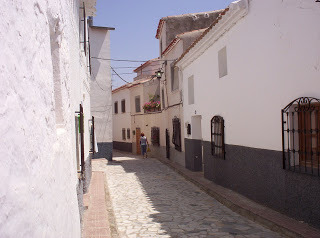
We began our tour in Chirivel, a delightful white-walled village just north of Albox.
The Roman road Via Augusta passes by Chirivel on its route from Cartagena to Cadiz, and I must say, the Romans knew how to choose a good spot. It's charms are still evident to this day.
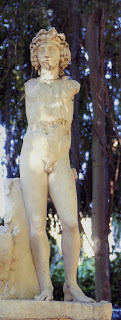
Valuable Roman remains were apparently found here, including the
figure of Dionisos, which has become the symbol of the town, although
the original has been moved to the Archaeological Museum of Almería.
The town is also famous for its pastry making, handed down from the time of the Moors, and for its honey. A small market was flourishing on the morning of our visit but I resisted buying one of the pretty song birds, hoping they would all find good homes.
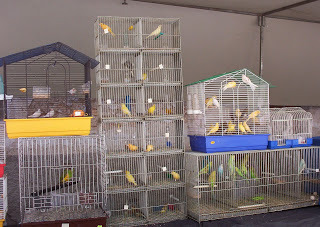
The poet Julio Alfredo Egea describes Chirivel as "with margins
populated by elder trees and poplars, inhabited by goldfinches and
nightingales."
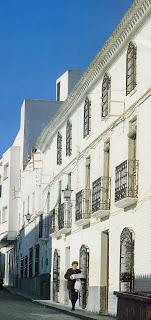
From here we moved on to the two brightest jewels of the Los Vélez region: Vélez Rubio and Vélez Blanco. Situated between the two can be found Los Letreros cave where you can see many prehistoric cave paintings, including the famous Indalo man. This has been adopted as a symbol for the entire area. "Indal eccius" means messenger of the gods. Collect the key from the tourist office and prepare to walk up many steps to satisfy your curiosity.
Lunch can be enjoyed at Meson el Molino (The Windmill), in Vélez Blanco, which has a high reputation locally, serving salmon, prawns, trout, veal, partridge and wonderful grilled meats. Not forgetting a mousse chocolat to die for.
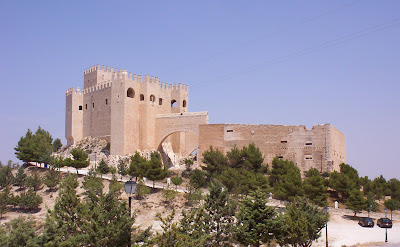
Not to be missed is the splendid Los Fajardo Castillo, the crown of Vélez Blanco, with the stunning vista of the sierra as back-drop. This was once the palace of the Marquis of Los Vélez, constructed at the beginning of the 16th century. Most of its contents have been sold to the Metropolitan Museum in New York, but it is still worth a visit for its architecture alone.
We have explored the castillo many times as Vélez Blanco is a favourite of ours, and today, after a pleasant walk around the town's quiet streets with its water fountains and Moorish quarter, it is a good place to finish our tour for today.



We began our tour in Chirivel, a delightful white-walled village just north of Albox.
The Roman road Via Augusta passes by Chirivel on its route from Cartagena to Cadiz, and I must say, the Romans knew how to choose a good spot. It's charms are still evident to this day.

Valuable Roman remains were apparently found here, including the
figure of Dionisos, which has become the symbol of the town, although
the original has been moved to the Archaeological Museum of Almería.
The town is also famous for its pastry making, handed down from the time of the Moors, and for its honey. A small market was flourishing on the morning of our visit but I resisted buying one of the pretty song birds, hoping they would all find good homes.

The poet Julio Alfredo Egea describes Chirivel as "with margins
populated by elder trees and poplars, inhabited by goldfinches and
nightingales."

From here we moved on to the two brightest jewels of the Los Vélez region: Vélez Rubio and Vélez Blanco. Situated between the two can be found Los Letreros cave where you can see many prehistoric cave paintings, including the famous Indalo man. This has been adopted as a symbol for the entire area. "Indal eccius" means messenger of the gods. Collect the key from the tourist office and prepare to walk up many steps to satisfy your curiosity.
Lunch can be enjoyed at Meson el Molino (The Windmill), in Vélez Blanco, which has a high reputation locally, serving salmon, prawns, trout, veal, partridge and wonderful grilled meats. Not forgetting a mousse chocolat to die for.

Not to be missed is the splendid Los Fajardo Castillo, the crown of Vélez Blanco, with the stunning vista of the sierra as back-drop. This was once the palace of the Marquis of Los Vélez, constructed at the beginning of the 16th century. Most of its contents have been sold to the Metropolitan Museum in New York, but it is still worth a visit for its architecture alone.
We have explored the castillo many times as Vélez Blanco is a favourite of ours, and today, after a pleasant walk around the town's quiet streets with its water fountains and Moorish quarter, it is a good place to finish our tour for today.

Published on February 24, 2012 08:30
February 17, 2012
Lancashire Markets
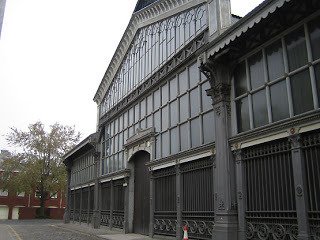 Lancashire to me means the warmth and good humour of the people, their laughter and song, and how they always bounce back with a joke when times are hard. It's the blast of the mill hooter, my Gran singing Thou Shalt Not Want in chapel three times of a Sunday, then wondering what she could find for tea. It's the smell of hot pie and peas, leather in my father's shoe shop, soot and smoke from the old mill chimneys. It's the crumbly delight of Lancashire cheese, the banter on Accrington market. It's the wild beauty of open, wind-swept moorland where I could play all day damming brooks and climbing trees, picnicking on a jam butty and a bottle of pop and nobody worried. It's skipping games and scraped knees, ice lollies, cobbled streets and chip butties. It's my childhood. It's what made me who I am.
Lancashire to me means the warmth and good humour of the people, their laughter and song, and how they always bounce back with a joke when times are hard. It's the blast of the mill hooter, my Gran singing Thou Shalt Not Want in chapel three times of a Sunday, then wondering what she could find for tea. It's the smell of hot pie and peas, leather in my father's shoe shop, soot and smoke from the old mill chimneys. It's the crumbly delight of Lancashire cheese, the banter on Accrington market. It's the wild beauty of open, wind-swept moorland where I could play all day damming brooks and climbing trees, picnicking on a jam butty and a bottle of pop and nobody worried. It's skipping games and scraped knees, ice lollies, cobbled streets and chip butties. It's my childhood. It's what made me who I am.And so I was inspired to write my Manchester sagas, this wonderful city representing the capital of the world to me when I was small. And Champion Street Market, a series of six books set in the 1950s around a market in Castlefield, Manchester. The fourth in the series, CANDY KISSES, is out now, although they can be read as stand-alone stories.
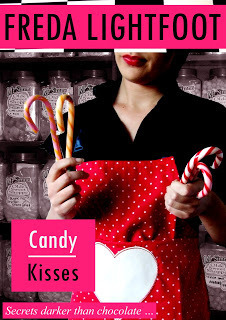
'Romance doesn't come sweeter than this tale of love and chocolate set in the grimy streets of 1950s Manchester.' Lancashire Evening Post
'The new series will be greeted with joy by the thousands of women who enjoy her books.' Evening Mail, Barrow-in-Furness
'You can't put a price on Freda Lightfoot's stories from Manchester's 1950s Champion Street Market. They bubble with enough life and colour to brighten up the dreariest day and they have characters you can easily take to your heart.'
The Northern Echo.
In 1950s Manchester, folk are just emerging from the shadow of the war. Money is still tight, and the bustling market is a source of tempting bargains – as well as the local gossip.
Everyone loves Aunty Dot's homemade sweets and chocolates. And everyone loves Aunty Dot: the plump, smiling woman has provided a loving home for many a troubled child. Lizzie Pringle would do anything for her foster mother – even taking on local sweet manufacturer and bully, Cedric Finch. Until she falls for his son, Barney…
Dena can't believe that Barry Holmes would hurt her beloved daughter: he's been like a favourite uncle to the little girl. But there's no smoke without fire. And chocolate can be bitter, as well as sweet …
Manchester's Champion Street market is the hub of the lively 'fifties community. Find out more about the stall-holders and their customers in Putting on the Style and Fools Fall in Love.
I based my fictional market on Campfield Market, situated between Tonman Street and Dumville Street, a large market hall which also had an outside market all around it.
There were food shops, pork butchers with red polonies hanging up, biscuit stalls where you could buy a bag of broken biscuits for sixpence; a milliner who sold bits and pieces with which to trim your hat.
On the outside market there would be stalls selling rolls of lino which the man would slap to make a noise and attract people. One auctioned pots and would juggle and drop one if no one was paying attention.
Once he had a crowd around him he'd say: 'Look at this beautiful plate. It's exquisite. Just like the pattern on our Lizzie's garters.' He was a showman, keen to make his audience laugh. He'd offer his pots at a ridiculous price, then beat down the price to sell.
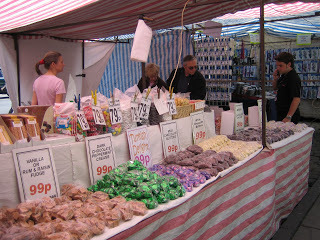
And then there were the sweet stalls, the ice cream parlour where you could choose to have raspberry syrup or chocolate sauce and other delights on your ice cream. Originally these were sold in a licking glass before the advent of wafers and cornets.
One man sold old uniforms and badges. He was a bit deaf and didn't like kids hanging around his stall, suspecting they were after nicking some of his treasures. Another old soldier would sell matches and boot laces from a tray. Kids used to help the stall holders pack away and stack up their stalls, hoping to earn a penny which would buy them a piping hot cup of Vimto.
The Maypole Dairy sold marg, butter, bacon and milk etc. The Flat Iron market sold second-hand clothes. And there was a little fairground as well. Lascars, or Indian seamen, sometimes called 'coolie johnnies' worked there.
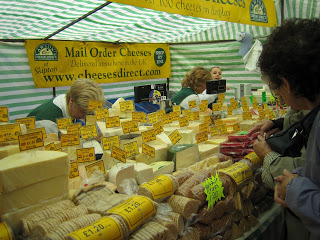
And there was a wonderful cheese stall which would give you a taster before you decided which to buy.
Markets have remained a strong tradition in Lancashire, and I still love browsing on them.
Using these memories I devised a cast of characters from Belle Garside, a fancy piece who runs the market café, to Aunty Dot who took in foster children, Winnie Watkins who pokes her nose into everybody's business, and Barry Holmes who gets more than he bargains for when he starts a boys' boxing club. The series begins with Putting On The Style
Then we have:
Fools Fall in Love
That'll Be The Day
and now: Candy Kisses

Published on February 17, 2012 08:30
February 6, 2012
Celebrating with trees
I was delighted to read that there is to be a mammoth planting of trees to celebrate the Queen's diamond jubilee. It will be called the Jubilee Wood Project and new areas of woodland are to be planted across Britain, one for each year of the Queen's reign. The Queen planted the first on her Norfolk estate, but local children also joined in. It reminded me of the many times in the past when I have been involved in a similar project, because you don't have to be the Queen in order to plant a few trees. Here I am with my Guide company planting a row of trees beside the River Kent in Kendal.
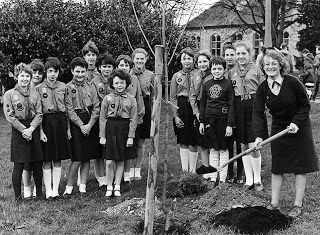
They are still alive, I'm pleased to say, and all those young girls involved are now young mums and can savour the pleasure of having added to the town's charms.
 Trees are also wonderful memorials to departed loved ones, so much better than a few flowers on a grave that will wither and die.
Trees are also wonderful memorials to departed loved ones, so much better than a few flowers on a grave that will wither and die.
They that say planting trees is an unselfish act because you may not live to see them mature. That depends, of course, what you plant. We once planted a wood of a thousand trees, on the two and a half acres (one hectare) when we lived in the Lake District.
We sought advice from the Forestry Commission on what to plant and on the day the advisor came, it was one of those typical Lakeland days, the rain sheeting down and blowing a gale. Undaunted, he and I put on our waterproofs and walked the land, not large, but high up on Shap fell, and talked, or rather shouted above the wind about what to plant where. He suggested oak and ash on the lower field, protected by the faster growing soft woods such as pine above, interspersed with hazel, rowan and silver birch, all indigenous species. He was totally against sycamore as he called these weeds. And we opted for a copse of Scots Pine on the bluff.
We bought the whips, as young trees are called, from a specialised nursery in the borders of Scotland, on the basis that if they could withstand Scottish weather, they could cope with the Lakes. We heeled them in first of all, to keep them alive, and then began the task of digging. It was great fun, not at a chore at all, and some of the pines we planted did go in lines so that we could easily locate them, but the hard woods were more decoratively spaced within their shelter. The entire family took part, including our two daughters, with the dogs doing their best to hinder us. We took some stick from local farmers who accused us of planting fox cover, but we felt it was a celebration of our love for the house and the area.
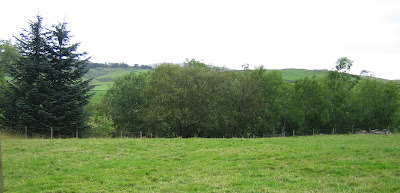
Today, 30 years on, we no longer live in that house. But we can still go back and visit the wood to view it from afar. Somewhat overgrown now, in parts, but from it a tree is given every year to the local church at Christmas time, and it still thrives. To me it is a memorial to the happy family life we enjoyed in that house.
Have I ever written about my love of trees? Of course, writers always use their personal memories and anecdotes whenever they can. Trees feature strongly in GRACIE'S SIN, a story of the timber Jills in World War Two. And THE BOBBIN GIRLS, set in Grizedale Forest. Interestingly, these are two of my most popular books, so maybe lots of other people love trees too. If so, then go out there and plant some, if it's only one in your garden. So go on, be like the Queen and celebrate with trees.


They are still alive, I'm pleased to say, and all those young girls involved are now young mums and can savour the pleasure of having added to the town's charms.
 Trees are also wonderful memorials to departed loved ones, so much better than a few flowers on a grave that will wither and die.
Trees are also wonderful memorials to departed loved ones, so much better than a few flowers on a grave that will wither and die.They that say planting trees is an unselfish act because you may not live to see them mature. That depends, of course, what you plant. We once planted a wood of a thousand trees, on the two and a half acres (one hectare) when we lived in the Lake District.
We sought advice from the Forestry Commission on what to plant and on the day the advisor came, it was one of those typical Lakeland days, the rain sheeting down and blowing a gale. Undaunted, he and I put on our waterproofs and walked the land, not large, but high up on Shap fell, and talked, or rather shouted above the wind about what to plant where. He suggested oak and ash on the lower field, protected by the faster growing soft woods such as pine above, interspersed with hazel, rowan and silver birch, all indigenous species. He was totally against sycamore as he called these weeds. And we opted for a copse of Scots Pine on the bluff.
We bought the whips, as young trees are called, from a specialised nursery in the borders of Scotland, on the basis that if they could withstand Scottish weather, they could cope with the Lakes. We heeled them in first of all, to keep them alive, and then began the task of digging. It was great fun, not at a chore at all, and some of the pines we planted did go in lines so that we could easily locate them, but the hard woods were more decoratively spaced within their shelter. The entire family took part, including our two daughters, with the dogs doing their best to hinder us. We took some stick from local farmers who accused us of planting fox cover, but we felt it was a celebration of our love for the house and the area.

Today, 30 years on, we no longer live in that house. But we can still go back and visit the wood to view it from afar. Somewhat overgrown now, in parts, but from it a tree is given every year to the local church at Christmas time, and it still thrives. To me it is a memorial to the happy family life we enjoyed in that house.
Have I ever written about my love of trees? Of course, writers always use their personal memories and anecdotes whenever they can. Trees feature strongly in GRACIE'S SIN, a story of the timber Jills in World War Two. And THE BOBBIN GIRLS, set in Grizedale Forest. Interestingly, these are two of my most popular books, so maybe lots of other people love trees too. If so, then go out there and plant some, if it's only one in your garden. So go on, be like the Queen and celebrate with trees.

Published on February 06, 2012 13:54
February 3, 2012
Our Caribbean Cruise
We treated ourselves to a fabulous Caribbean cruise this Christmas on the Emerald Princess, which I must say was wonderful. Here she is, looking very grand.

We sailed from Fort Lauderdale on a lovely sunny day in mid December and our first stop off was at Princess Cays where we relaxed on the beach and enjoyed a barbecue.

The iguana is enjoying the sun as much as us.

Our next island was St. Thomas. Here we visited St. Peter Great House
and gardens where there are 150 species of Caribbean plants. The island
was named by Christopher Columbus in 1493, and later Sir Francis Drake
used to lie in wait for Spanish treasure ships in the quiet waters of
Magens Bay. Blackbeard and Captain Kidd also used this as a safe
harbour.

Dominica was lovely, very natural, where we enjoyed a visit to a waterfall, saw a huge banyan tree in the botanical gardens, and a bus that had been flattened in a typhoon. Glad it wasn't ours.


One of our favourite islands was Grenada where we visited a spice estate. The guy in the picture is moving the cocoa beans in order to help them dry out. We were shown how nutmeg and mace were produced, and later visited the distribution centre.
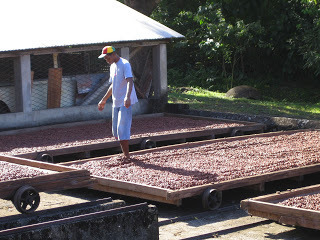
Did you know that loofahs grow on trees? No, neither did I, but apparently they do.
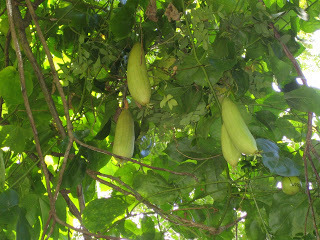
On Bonaire, part of the Dutch Antilles, we went out on a glass bottomed boat to look at the fishes and coral. We even saw a great big sting ray. Amazing! And this Pirates of the Caribbean type ship.

Our last excursion was Christmas Day where we visited a butterfly farm on Aruba. I loved the butterflies, which were huge and brightly coloured. The pair the woman is holding were mating. Well, it has to be done somehow.
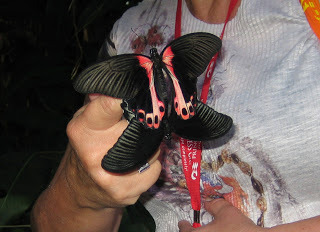
And this is an owl butterfly, named for its markings.

And another pretty one.

I bought some face cream at an aloe vera factory, of course, and learned something about the medicinal properties of this plant, which I do grow in my Spanish garden. Very interesting, and useful for sting relief. Just slice the spikes off the leaf first, then peel back the green part to reach the sappy bit. Rub that on the sting and you'll feel much better. There's also a lovely shopping centre on Aruba, but as it was Christmas Day, it was closed.

There was plenty of entertainment on board, including a brilliant tribute band, the Beatle Maniacs, who were superb. Lots of excellent dining, dancing, music and shows, and plenty of excuses to dress up. Great fun! And you can watch the movie while you swim.

We shall certainly be cruising again.



We sailed from Fort Lauderdale on a lovely sunny day in mid December and our first stop off was at Princess Cays where we relaxed on the beach and enjoyed a barbecue.

The iguana is enjoying the sun as much as us.

Our next island was St. Thomas. Here we visited St. Peter Great House
and gardens where there are 150 species of Caribbean plants. The island
was named by Christopher Columbus in 1493, and later Sir Francis Drake
used to lie in wait for Spanish treasure ships in the quiet waters of
Magens Bay. Blackbeard and Captain Kidd also used this as a safe
harbour.

Dominica was lovely, very natural, where we enjoyed a visit to a waterfall, saw a huge banyan tree in the botanical gardens, and a bus that had been flattened in a typhoon. Glad it wasn't ours.


One of our favourite islands was Grenada where we visited a spice estate. The guy in the picture is moving the cocoa beans in order to help them dry out. We were shown how nutmeg and mace were produced, and later visited the distribution centre.

Did you know that loofahs grow on trees? No, neither did I, but apparently they do.

On Bonaire, part of the Dutch Antilles, we went out on a glass bottomed boat to look at the fishes and coral. We even saw a great big sting ray. Amazing! And this Pirates of the Caribbean type ship.

Our last excursion was Christmas Day where we visited a butterfly farm on Aruba. I loved the butterflies, which were huge and brightly coloured. The pair the woman is holding were mating. Well, it has to be done somehow.

And this is an owl butterfly, named for its markings.

And another pretty one.

I bought some face cream at an aloe vera factory, of course, and learned something about the medicinal properties of this plant, which I do grow in my Spanish garden. Very interesting, and useful for sting relief. Just slice the spikes off the leaf first, then peel back the green part to reach the sappy bit. Rub that on the sting and you'll feel much better. There's also a lovely shopping centre on Aruba, but as it was Christmas Day, it was closed.

There was plenty of entertainment on board, including a brilliant tribute band, the Beatle Maniacs, who were superb. Lots of excellent dining, dancing, music and shows, and plenty of excuses to dress up. Great fun! And you can watch the movie while you swim.

We shall certainly be cruising again.

Published on February 03, 2012 11:50
January 6, 2012
Three Kings Day
Traditionally, Spanish children do not get their presents on Christmas Day from Santa Claus, or Papa Noel, as he is called. They have to wait until the Fiesta de Los Reyes. What we would call Epiphany. By now we're packing our Christmas decorations away, but the Spanish are still partying.
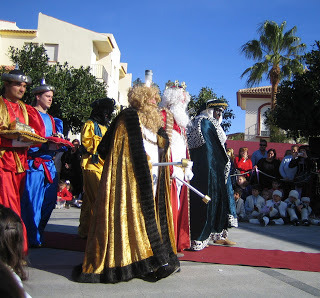
In the run up to the 6th of January, children can meet the wise men at some department stores and tell them what they would like for Christmas, just as our children tell Santa Claus. On the 5th, the excitement starts in the late afternoon or early evening. Locally, the three kings: Melchor, Gazpar and Baltasar, arrive by sea at Garrucha in the evening, then parade through the streets and throw sweets into the watching crowds. A custom that no doubt started in Moorish times.
A whole procession of dancers and musicians, trailers and even floats,
will follow. Children run around with their little bags catching their
gifts. It is truly a sight to see. The little girls dress up in their flamenco dresses, little boys as kings, drummers or shepherd boys. And the
shops remain open until after midnight.
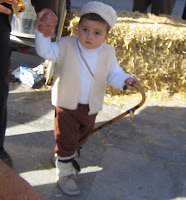
Before going to bed the children leave their shoes on the door step so that the Kings will know who to leave presents for. And just as British children leave a mince pie and a drink for Santa
and his reindeer, Spanish children also put out something to eat and
drink for Melchor, Gaspar, and Baltazar, and water and grass for their
camels. Well they do have a lot of work to do that night.
The children wake in great excitement the next morning to find their presents. The 6th itself is fiesta day when there are often medieval fairs held, and celebrations of all kinds. Great fun for all the family.
A play is held in the town square which tells the story of Herod ordering his roman soldiers to seek out this new king which has been born.
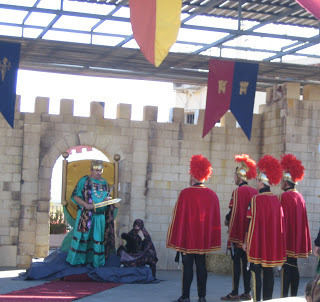
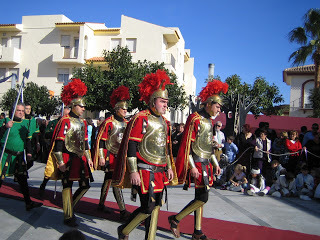
There are stalls selling trinkets, toys, food and other goodies.
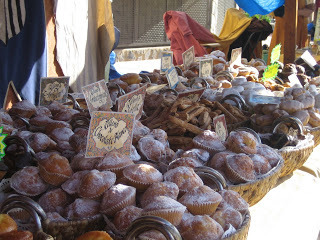
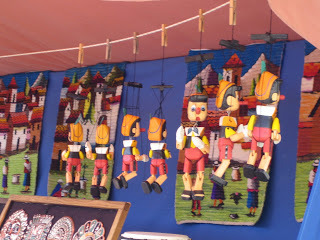
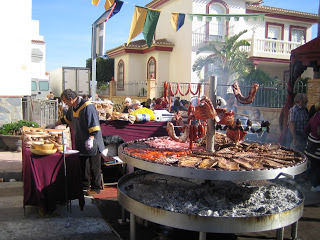
You can see potters and craftsmen going about their work. There are donkeys, geese and turkeys on display, giving a real biblical feel to the fair.
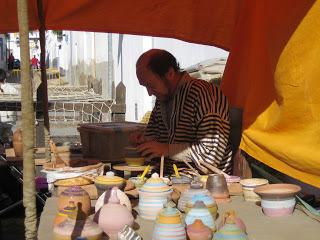
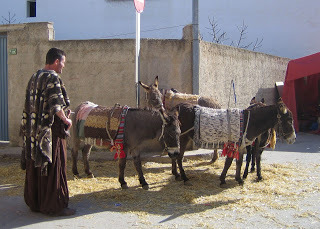
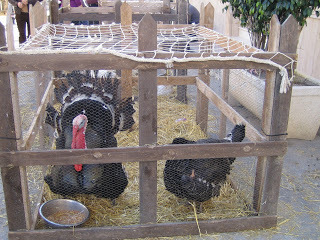
Next come musicians, jugglers and jokers with games for the children to play on this special day. Always lots of sweets and fun for the children.
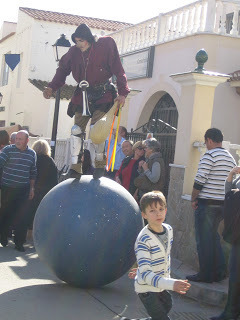
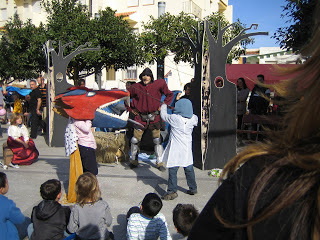
The medieval fool helps the children act out a pay with a dragon, knights and moors. All to rescue a princess, of course. Very like the mummer's play we do in the UK.
After lunch, families eat the typical dessert of the day, the 'Roscón de los Reyes'. This is a large ring shaped cake or sweet bread that is decorated with candied fruits, symbolic of the emeralds and rubies that adorned the robes of the three kings, sometimes a gold paper crown is often provided to decorate the cake. Hidden inside it are surprises 'sorpresas'. The one who finds the lucky prize is King or Queen for the day while he who ends up with the unlucky bean is expected to pay for next years Kings' Cake – and they are not cheap!
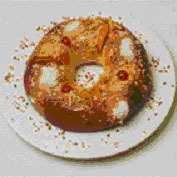
January 7 is a very quiet day in Spain. No businesses open, everyone at home in recovery.
Happy Three King's Day everyone.


In the run up to the 6th of January, children can meet the wise men at some department stores and tell them what they would like for Christmas, just as our children tell Santa Claus. On the 5th, the excitement starts in the late afternoon or early evening. Locally, the three kings: Melchor, Gazpar and Baltasar, arrive by sea at Garrucha in the evening, then parade through the streets and throw sweets into the watching crowds. A custom that no doubt started in Moorish times.
A whole procession of dancers and musicians, trailers and even floats,
will follow. Children run around with their little bags catching their
gifts. It is truly a sight to see. The little girls dress up in their flamenco dresses, little boys as kings, drummers or shepherd boys. And the
shops remain open until after midnight.

Before going to bed the children leave their shoes on the door step so that the Kings will know who to leave presents for. And just as British children leave a mince pie and a drink for Santa
and his reindeer, Spanish children also put out something to eat and
drink for Melchor, Gaspar, and Baltazar, and water and grass for their
camels. Well they do have a lot of work to do that night.
The children wake in great excitement the next morning to find their presents. The 6th itself is fiesta day when there are often medieval fairs held, and celebrations of all kinds. Great fun for all the family.
A play is held in the town square which tells the story of Herod ordering his roman soldiers to seek out this new king which has been born.


There are stalls selling trinkets, toys, food and other goodies.



You can see potters and craftsmen going about their work. There are donkeys, geese and turkeys on display, giving a real biblical feel to the fair.



Next come musicians, jugglers and jokers with games for the children to play on this special day. Always lots of sweets and fun for the children.


The medieval fool helps the children act out a pay with a dragon, knights and moors. All to rescue a princess, of course. Very like the mummer's play we do in the UK.
After lunch, families eat the typical dessert of the day, the 'Roscón de los Reyes'. This is a large ring shaped cake or sweet bread that is decorated with candied fruits, symbolic of the emeralds and rubies that adorned the robes of the three kings, sometimes a gold paper crown is often provided to decorate the cake. Hidden inside it are surprises 'sorpresas'. The one who finds the lucky prize is King or Queen for the day while he who ends up with the unlucky bean is expected to pay for next years Kings' Cake – and they are not cheap!

January 7 is a very quiet day in Spain. No businesses open, everyone at home in recovery.
Happy Three King's Day everyone.

Published on January 06, 2012 09:07
December 10, 2011
A Most Memorable Fijian Christmas
How do you fancy being woken on Christmas morning with a slice of Christmas cake, brought to you by the maid? All right, it was only 7.20 a.m. and our thanks may have been somewhat muted, but the sun was shining, the temperature outside was already over 20 degrees and we happily drifted back to sleep. I believe carol singers came round at 8 but we never heard them.

We were in Fiji, stopping off for a three day Christmas break on our way back from exploring New Zealand, and loving every minute of it.
On Christmas Eve we'd been entertained by a Fijian steel band, a fire dancing ceremony, and a group of school children singing I'm Dreaming of a White Christmas, which somehow seemed unlikely.


We spent Christmas Day relaxing by the pool and walking on the white sandy beach, gazing out at an impossibly blue Pacific ocean. After exchanging our gifts over a glass of wine in our burra, (a classy sort of cabin set right on the beach), we put on our best togs and went into dinner.
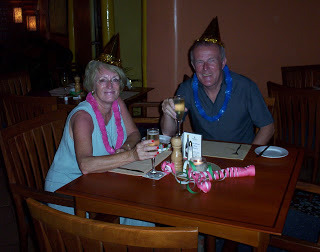
The choice of food was mind boggling, meant to cater for every nationality or taste. Here we enjoying the champers while waiting to be served.
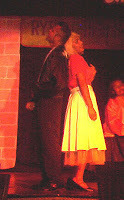
But the highlight of the evening was a rendition of Grease put on by the staff. I've never seen anything so funny. They entered into the spirit of it wonderfully, miming the words, and singing and dancing with great gusto. Sandra's blond wig atop a beautiful black face struck a delightfully incongruous note. And the young male waiters who did the car scene were seriously gorgeous! They really hammed it up wonderfully. Great fun!

Next came a fire dance, and after that, the disco,
Then we went to ring our daughter back home in the UK. We couldn't get through but were more successful on Boxing Day morning. 'Happy Birthday,' I said, since that's what it was. 'Oh, is it tomorrow there,' she said, delighted we'd rung. 'It's still today here.'
It's a strange feeling to have crossed the date line, but a wonderful Christmas escape.
This year we're off on a Caribbean cruise. I'll tell you all about that when I get back.


We were in Fiji, stopping off for a three day Christmas break on our way back from exploring New Zealand, and loving every minute of it.
On Christmas Eve we'd been entertained by a Fijian steel band, a fire dancing ceremony, and a group of school children singing I'm Dreaming of a White Christmas, which somehow seemed unlikely.


We spent Christmas Day relaxing by the pool and walking on the white sandy beach, gazing out at an impossibly blue Pacific ocean. After exchanging our gifts over a glass of wine in our burra, (a classy sort of cabin set right on the beach), we put on our best togs and went into dinner.

The choice of food was mind boggling, meant to cater for every nationality or taste. Here we enjoying the champers while waiting to be served.

But the highlight of the evening was a rendition of Grease put on by the staff. I've never seen anything so funny. They entered into the spirit of it wonderfully, miming the words, and singing and dancing with great gusto. Sandra's blond wig atop a beautiful black face struck a delightfully incongruous note. And the young male waiters who did the car scene were seriously gorgeous! They really hammed it up wonderfully. Great fun!

Next came a fire dance, and after that, the disco,
Then we went to ring our daughter back home in the UK. We couldn't get through but were more successful on Boxing Day morning. 'Happy Birthday,' I said, since that's what it was. 'Oh, is it tomorrow there,' she said, delighted we'd rung. 'It's still today here.'
It's a strange feeling to have crossed the date line, but a wonderful Christmas escape.
This year we're off on a Caribbean cruise. I'll tell you all about that when I get back.

Published on December 10, 2011 16:57
November 24, 2011
First olive picking of 2011
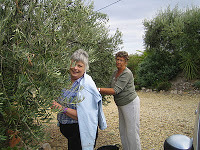
A lovely November day, our friends gathered to help and we enjoyed a pleasant day picking olives. It's a steady job, and no, we don't grab hold of the tree and shake it, although I know the big machines do that in the large olive groves.
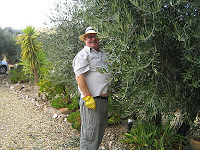
Fortunately, we only have 30 trees, some more productive than others, so
we comb them off with our hands. The big fat ones are always just out
of reach, even after you've climbed the ladder.
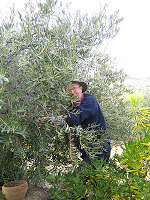
We picked 145 kilos which produced 23 litres of extra virgin olive oil.
Not a bad start. There are plenty more on the trees, not yet quite ripe,
and we now have rain, so they'll have to wait.
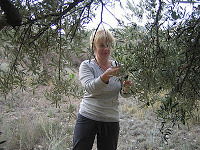
We paused for a substantial lunch of chilli and fruit crumble, washed
down with plenty of wine. Those still sufficiently sober continued
picking into the late afternoon, after which we loaded up the sacks and
took them to our local cooperativa.

Jess keeps an eye on us to check we do the job properly.
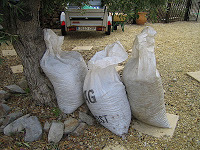
Here's the crop all ready to go. Not a particular good one this year due to a dry spring. But there are still more olives yet to ripen.

David backs up to the weighing platform.
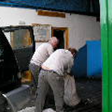
Tony helps him to unload and tip the olives out into the press.

Here the crop is being taken up the conveyor belt.

Our olives are tested in the office for the correct level of acidity.
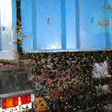
A lorry comes next and starts to unload.
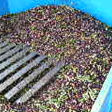
He has a much bigger crop than us.
Some interesting facts about olive oil:
Olive oil will soon become rancid in the light and
heat. Buy the best quality extra virgin olive oil and store in dark
tinted bottles in a cool cupboard.
Olives were first grown in Crete between 5 and 7 thousand years ago.
There are about 700 cultivated varieties of olives. Wild ones are much smaller.
The tastes can vary from peppery to nutty, grassy or like green apples.
It can provide food, fuel, timber and medicine, and is a preservative.
You can use it as a furniture polish. Mix 2 tablespoons olive oil with 1 tablespoon lemon juice or white vinegar. Place in a spray bottle, shake well. Spray furniture lightly. Wipe off with a clean cloth or kitchen roll.
Olive oil has about 120 calories per tablespoon but unlike other cooking oils it is rich in vitamins A and E, and actually good for you.
It is a staple in the Mediterranean diet, and known to reduce the risk of heart disease. It is mono unsaturated, rich in vitamins, iron, oleic acid, sodium and potassium, and can improve circulation and lower blood pressure.
Olive oil has many other health giving properties. It is good for the digestion, helps to lower blood sugar levels, and can even be used to relieve the pain of burns, itches, stings and insect bites.
Best of all, olive oil encourages cellular growth, helps healing and slows down the aging process.
Olive oil as a beauty aid:
For dry and brittle hair
After shampooing, rinse your hair with a mix of half a cup of olive oil and beaten egg. Leave on for 15 minutes covered with a plastic cap before rinsing clean.
Hair conditioner
Warm half a cup of olive oil and apply liberally to your hair. Wrap in a towel for 30 minutes, then shampoo and rinse thoroughly.
Facial
Add 1 tablespoon of olive oil to 2 tablespoons fresh cream. Smooth on the face and leave for 10 minutes. Wash your face with warm water.
Brittle nails
Soak your nails in a small bowl of warm olive oil with a squeeze of lemon or rose water, to add a nice scent.
Olive oil is also good for softening hands and feet, moisturising cuticles, removing mascara and eye liner, or mix with a touch of lavender essential essence and add to your bath water.
It can be used in place of shaving cream, will clear up acne (add 4 tablespoons of salt to 3 tablespoons of olive oil), and even loosen chewing gum from hair.
Olive oil is a miracle product provided for us by nature.

Published on November 24, 2011 15:12
November 4, 2011
Book collecting on a Budget
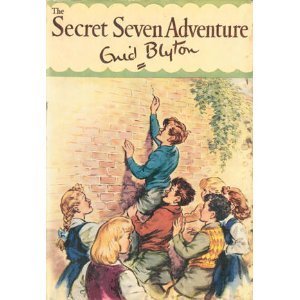
A while ago I was clearing out my loft when I came across some old Enid Blyton books I had enjoyed as a child. Needless to say, the clearing out went to pot and I spent the rest of the morning in happy pursuit of childhood pleasures. Since then I have begun to collect secondhand books, finding them in unexpected and fascinating places.
What makes book collecting exciting is that you don't have to be an expert seeking rare specimens. You can have just as much fun buying cheap paperbacks. And bookaholics like myself still love to do that, even in this age of the Kindle and ebooks.
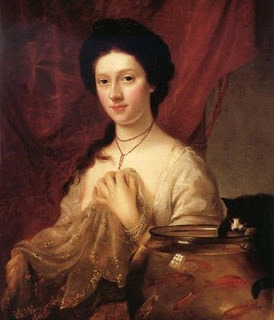
The first thing to do is choose your area of interest. It might be a particular subject such as the countryside, biographies, old cookery books or you may be a local history buff and collect books on your own region. I seem to be currently obsessed with books about the theatre, eighteenth century actresses and courtesans. I've no idea why but I just love reading about them.
Is there a particular author that you love? Find one who has a number of books to their credit to make them more interesting to collect, but it doesn't matter whether it's Agatha Christie, Lee Child or Georgette Heyer, so long as you like them. Or perhaps you wish to collect a certain type of fiction such as thrillers or romantic novels.
Old magazines are also fascinating. Maybe you love nostalgia and would enjoy collecting nursery or children's books. You can do this not only by author, but also by illustrator, period or by age group. Don't neglect the more modern or mundane classifications of books such as those connected with TV series, films or a much-loved character. Remember that today's books and magazines are tomorrow's collectors items.
Market stalls are an obvious starting point, but try also charity shops such as Oxfam, Red Cross and Help the Aged, who often have shelves of cheaply priced books, and you have the added pleasure of helping them every time you buy anything. Rummage sales are another rich source where you can often pick up real treasures at remarkably low prices. Try secondhand bookshops by all means, and any local book fairs, but set your sights low, at least until you know your material; expensive antiquarian bookshops are for the affluent.
Once you start looking, you'll be surprised just how many places have cheap collectable books. Get into the habit of going regularly, and you'll be on hand when something exciting turns up.

Don't be shy about asking relatives or friends. They may have just what you want tucked away in their attic or garage. Often they're glad of a chance to have a clear out and are pleased to see the books go to someone who will appreciate them. House sales or auctions often sell whole boxes of books for a pittance and you can have a lovely browse through them at home before selling the ones you don't want back to a market stall holder.
Having got into the swing of your collection, you will soon want to know more about your chosen subject. Collect all the information you can find on it. Newspaper and magazine cuttings are a good source as well as the internet. Keep a record of what you've bought, and how much you paid.
What should you look for when buying a book? How do you know if it's worth the price? What sort of condition should it be in? All these questions may puzzle the beginner, but they needn't. The question of price is the easiest to answer: as little as possible. At rummage sales you can pick up copies for a few pence, but the condition will be variable. At charity shops you may pay a little more but the condition will be better. In the trade there are various descriptions known as standard book conditions for grading secondhand books. Mint means that a book is perfect, complete with dust jacket and indistinguishable from a new copy. Fine means that it has a dust jacket and is in excellent condition but has clearly been read. A very good book may have no dust jacket or a faded cover, and one that is classed only as good will show definite signs of use but will be complete, with no pages missing. Finally, the book in poor condition may be warped, show signs of damp or mildew damage to the spine. It should nevertheless be a complete copy even if the title page is missing. If it is foxed, it will have brown stains, often caused by age.
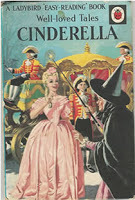
Don't be put off buying a book simply because it is in poor condition. It may be more valuable than it at first appears, particularly if it has some good illustrations. Ladybird books are a good example, since the early editions are very collectable. But even if it has no great value other than as a reading copy, there is a good deal of pleasure to be derived from this alone. Times can change the situation if finer copies become rare. Collectors on a tight budget shouldn't worry about looking for first editions or mint copies. Buy what you fancy. Try for a good copy, but if you find a title you want in poor condition, pay less.
Books are going to become even more rare in this digital age, so start collecting now.
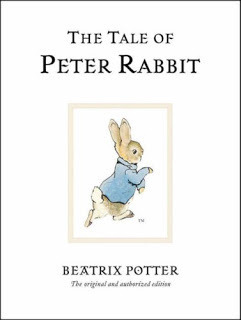
There is always the possibility that you might find something really valuable. A friend of mine once discovered an old copy of Peter Rabbit, autographed by Beatrix Potter herself.

Published on November 04, 2011 08:00
October 21, 2011
Corsets, Whalebones and Waist-whittlers
'A Corset is of sterling worth in aiding and beautifying the figure.'
Have you ever considered a corset as a status symbol; a means of class distinction? Surprising as it may seem the corset once ranked high among the status symbols of our forefathers, or mothers, as the case may be. The woman who could not stoop to retrieve her fallen fan, could exert herself sufficiently to tinkle a handbell for her maidservant who, uncorseted, or at least should be if she wanted to keep her position, could retrieve it for her.
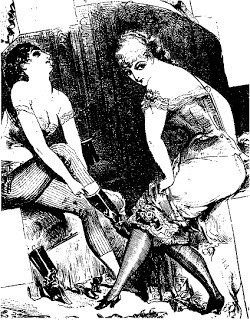
The corset has of course other functions. Its main one being to support and mould the figure into the shape dictated by the fashion of the day. It has always had its erotic associations, making the wearer feel attractive and feminine and no doubt decidedly uncomfortable.
We first hear of the corset in early Mediaeval England, when the Monks wrote of the evils of tight lacing and bustling, saying that it caused deformity. They failed to stamp out this pernicious habit for by the sixteenth century the corset was an accepted part of a lady's wardrobe.
It was made of stiff leather, wood or even iron supports, with large semi-circular side pieces laced on. The stomacher, a flat placard, was fastened to the front and pulled tightly in at the waist, leaving the hips free. Elizabeth I pioneered the use of whalebones in corsets, but as ever, this wily Queen was motivated mainly by economic reasons.
By the seventeenth and eighteenth centuries, corsets were even worn in the nursery. A lady of quality along with her young daughters, wore a 'pair of bodies' stiffened with busks of wood or whalebone with back lacing, the lower part open to ride over the hips.
During the Regency period when clinging, neo-Grecian lines were the mode, the corset fell from favour. Undeterred, the corset makers turned their attention to the male of the species who was at that time preening himself unashamedly. The 'dandies' took to the 'Cumberland Corset' or the 'Brummell Bodice'. Even the Prince Regent laced himself into stays and the less kind among his contemporaries considered him to be in need of such support.
[image error]
It was the Victorian era, however, which saw the corset fashion at its height. The waist reverted to its normal position and tight lacing was once more evident. There is no doubt that much of the ill health and fainting fits of the time were attributed to this. Young girls considered it desirable to marry with age and waist measurements the same - preferably less than twenty-one. A lady of fashion might even have ribs removed to achieve the desired effect and on no account would she be seen without her corset, even in bed.
Metal eye-holes and india-rubber came to be used during the Industrial Revolution and in 1860, elastic panels were introduced. As skirts tightened in the 1870's so the corset lengthened and here we see the birth of the suspender. The naughty 1990's saw a devastating array of frills, laces, bows and paint box colours, the most popular being cardinal red and canary yellow, hidden beneath a starched Victorian facade. There were dual purpose corsets with chemise tops which could be used for day and evening wear, in black, white or cardinal silk coutille.
At the turn of the century came the so-called health corset which flattened the stomach, thrusting the bosom forward and the hips back thus creating the mature, solid S-shape. Advertisements emphasised the beneficial effects of these corsets in relieving the hips of the weight of the skirt and preventing stooping. Shoulder braces were also available for wearing over the corset. Well encased, the Victorian mama and her daughter would be quite incapable of stooping.
There were corsets for every occasion. Cycling was becoming fashionable and a special cyclist's corset with elastic sides was produced. A writer commenting in a shopping guide of a woman's magazine of 1894 shows the attitude of the day on the wearing of corsets when she says 'I wish fat people could be persuaded to wear them for tennis.'
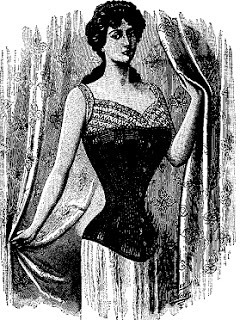
In 1902 came the unbreakable corsets with triple steel busks, and in 1903 the featherbone which was composed of quill fibre and claimed to replace old-fashioned whalebone. The 'solo' corset of 1905 introduced invisible lacing which could be adjusted by the wearer at the pull of a string. At this time too appeared the reducing corset with an elastic abdominal belt.
After the great war things were never the same again. The boy look of the 1920s brought in the use of 'flatteneds', a sheath-like garment which fitted from armpits to thighs and dispelled any shape whatsoever.
In the 1930s came the 'two-way stretch' reminding women once more of the comfort and grace of being natural. In the summer of 1939 the corset almost made a comeback, for waists were nipped in and advertisers promised laced up corsets made from the newest materials. The second world war ended this fashion abruptly; women had to work and working women have no time for the restrictions of tight lacing.
Since the war the move has been towards an even greater freedom. The use of nylon and Lycra and the fashion for young, natural lines have released women from a bondage most of us have no wish to see return.
 [image error]
[image error]
Have you ever considered a corset as a status symbol; a means of class distinction? Surprising as it may seem the corset once ranked high among the status symbols of our forefathers, or mothers, as the case may be. The woman who could not stoop to retrieve her fallen fan, could exert herself sufficiently to tinkle a handbell for her maidservant who, uncorseted, or at least should be if she wanted to keep her position, could retrieve it for her.

The corset has of course other functions. Its main one being to support and mould the figure into the shape dictated by the fashion of the day. It has always had its erotic associations, making the wearer feel attractive and feminine and no doubt decidedly uncomfortable.
We first hear of the corset in early Mediaeval England, when the Monks wrote of the evils of tight lacing and bustling, saying that it caused deformity. They failed to stamp out this pernicious habit for by the sixteenth century the corset was an accepted part of a lady's wardrobe.
It was made of stiff leather, wood or even iron supports, with large semi-circular side pieces laced on. The stomacher, a flat placard, was fastened to the front and pulled tightly in at the waist, leaving the hips free. Elizabeth I pioneered the use of whalebones in corsets, but as ever, this wily Queen was motivated mainly by economic reasons.
By the seventeenth and eighteenth centuries, corsets were even worn in the nursery. A lady of quality along with her young daughters, wore a 'pair of bodies' stiffened with busks of wood or whalebone with back lacing, the lower part open to ride over the hips.
During the Regency period when clinging, neo-Grecian lines were the mode, the corset fell from favour. Undeterred, the corset makers turned their attention to the male of the species who was at that time preening himself unashamedly. The 'dandies' took to the 'Cumberland Corset' or the 'Brummell Bodice'. Even the Prince Regent laced himself into stays and the less kind among his contemporaries considered him to be in need of such support.
[image error]
It was the Victorian era, however, which saw the corset fashion at its height. The waist reverted to its normal position and tight lacing was once more evident. There is no doubt that much of the ill health and fainting fits of the time were attributed to this. Young girls considered it desirable to marry with age and waist measurements the same - preferably less than twenty-one. A lady of fashion might even have ribs removed to achieve the desired effect and on no account would she be seen without her corset, even in bed.
Metal eye-holes and india-rubber came to be used during the Industrial Revolution and in 1860, elastic panels were introduced. As skirts tightened in the 1870's so the corset lengthened and here we see the birth of the suspender. The naughty 1990's saw a devastating array of frills, laces, bows and paint box colours, the most popular being cardinal red and canary yellow, hidden beneath a starched Victorian facade. There were dual purpose corsets with chemise tops which could be used for day and evening wear, in black, white or cardinal silk coutille.
At the turn of the century came the so-called health corset which flattened the stomach, thrusting the bosom forward and the hips back thus creating the mature, solid S-shape. Advertisements emphasised the beneficial effects of these corsets in relieving the hips of the weight of the skirt and preventing stooping. Shoulder braces were also available for wearing over the corset. Well encased, the Victorian mama and her daughter would be quite incapable of stooping.
There were corsets for every occasion. Cycling was becoming fashionable and a special cyclist's corset with elastic sides was produced. A writer commenting in a shopping guide of a woman's magazine of 1894 shows the attitude of the day on the wearing of corsets when she says 'I wish fat people could be persuaded to wear them for tennis.'

In 1902 came the unbreakable corsets with triple steel busks, and in 1903 the featherbone which was composed of quill fibre and claimed to replace old-fashioned whalebone. The 'solo' corset of 1905 introduced invisible lacing which could be adjusted by the wearer at the pull of a string. At this time too appeared the reducing corset with an elastic abdominal belt.
After the great war things were never the same again. The boy look of the 1920s brought in the use of 'flatteneds', a sheath-like garment which fitted from armpits to thighs and dispelled any shape whatsoever.
In the 1930s came the 'two-way stretch' reminding women once more of the comfort and grace of being natural. In the summer of 1939 the corset almost made a comeback, for waists were nipped in and advertisers promised laced up corsets made from the newest materials. The second world war ended this fashion abruptly; women had to work and working women have no time for the restrictions of tight lacing.
Since the war the move has been towards an even greater freedom. The use of nylon and Lycra and the fashion for young, natural lines have released women from a bondage most of us have no wish to see return.
Published on October 21, 2011 00:00
October 6, 2011
How to create suspense
At its most basic, suspense is the art of the reader knowing more than the main character does.
E.g the famous shower scene in Psycho. Sometimes the reverse is true and withholding information can also be effective. A character may receive a letter or phone call, giving vital information to the protagonist but not the reader. Choosing the right moment to give in to the reader's need-to-know is a skill you develop with practise. Too soon and the reader is disappointed, too late and she grows bored and irritated. It's a useful ploy to have presented a second problem before resolving the first.
Here are some other techniques you can use to add suspense in all types of fiction.
Cut:
Cutting to another character or situation. This keeps the reader guessing and hopefully breathless with anticipation as they are taken to another part of the story. From time to time you can remind them of what they are still waiting to learn, or take them back and give them a snippet more to wet their appetite. Increase the suspense before you deliver. Milk a scene without slowing the story down.
Fear of the unknown:
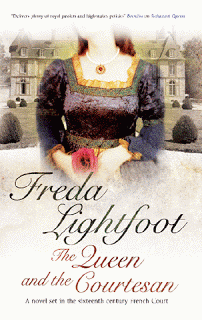
Uncertainty of outcome helps to create tension and fear. In THE QUEEN AND THE COURTESAN Henriette d'Entragues was terrified when Henry IV had her arrested. Would she be tortured, or even lose her head? In THE FAVOURITE CHILD, Isabella Ashton became nervous when she suspected Billy Quinn was following her. Did he mean to hurt her or was he simply fascinated by her?
Forewarning and pointers:
These can appear at different points in the book like a promise or threat of dangers which might (or might not) happen. But don't make these too blatant, or you'll fall into the trap of the 'dear reader' style. Keep the reader guessing. I find that if a twist in the plot occurs to me as I am writing, I often have to go back and put these in.
Red herrings:
These are pointers which deliberately lead nowhere. They too can create real suspense and fear. Common in detective fiction, even in general fiction they can be used to good effect. But don't lead the reader down too many false trails or the story will lose credibility.
The worsening scenario:
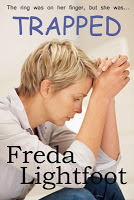
Start with a feeling of unease, a hint that something isn't quite right, or a person not as pleasant or innocent as they at first appeared. Gradually the menace builds and increases to develop a sense of dread, finally panic or terror. I used this to great effect in TRAPPED, where the wife is subject to a bullying and controlling husband.
False hope:
The character believes all is well. The reader thinks otherwise. Who is right?
Mental ordeal:
An overwrought imagination can make a nightmare out of a crisis. The viewpoint character's turmoil and emotion can add atmosphere to a story through their mental anguish. This may cause her to imagine things that aren't actually happening to her. She might think she is being followed, or see someone she thought was dead. It might be real, it might not. Her fears may erupt into dreams, delusions or hallucinations.
Failed communication and unexplained happenings:
A letter not delivered. Secrets withheld. THE PROMISE is based on a family secret. Chrissie wants to know why her mother's name was changed? Why she never met her grandmother. There must be a strong motivation why a secret is withheld and not just to keep the reader reading. Deliberate lies are also a good plot device, again with proper motivation. Is her boy friend telling the truth about where he was last night? Can she trust him? Who-how-why was her kitchen ransacked when she's certain she bolted every door and window? No one will believe there's anything wrong because the body has vanished.
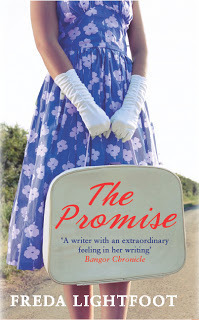
Pursuit:
She is being pursued and there must be a real danger of her getting caught. Does she know who by? Establish the motivation of why she is being pursued, how she is trying to escape, and what stakes are involved besides her own safety. Whether or not she will succeed must always be in doubt until the conclusion.
Immediacy:
Give her only a limited time in which to achieve her goal. This is a device usually piled on top of the original quest, and makes for an even more compulsive story.
Surprise and shock:
Surprise is a very effective weapon. Sometimes it is useful to practise a little sleight of hand, leading the reader along one path and then hitting them from another direction. It must be logical though, even if it is not what they expected to hear. Perhaps they didn't notice an earlier clue you carefully disguised as a red herring. Twists and turns of the plot keep the reader guessing. Don't fully explain something, disguise or withhold the whole truth, but don't overdo this or you might irritate and confuse. Agatha Christie was a master at this device.
Horror:
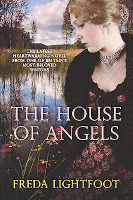
This can be useful in all types of fiction, including romantic. I've written some pretty gruesome scenes in some of my own sagas, including the opening scene in HOUSE OF ANGELS when Livia is being beaten by her father. Judge the degree of horror that is right for the story, according to the genre you are writing. Make sure it is essential and not gratuitous. It should have a genuine purpose in the plot, and be properly woven into the story or the reader might skip it.
Atmosphere:
Gothic type atmospherics are not so popular these days and don't usually work as well in print as in film, but you should and must appeal to the senses. The weather, the place, the time of day or night, smells, textures, sounds can all evoke a sense of doom or fear. Try to appeal to the reader's imagination but don't overdo it or you might tip it into farce. Remember the atmosphere can serve as a contrast to the protagonist's mood or emotion.
New out this month:
THE PROMISE
ISBN 9780749008291
Allison & Busby
26 September
Hardback 19.99
Chrissie Kemp visits her grandmother and discovers a shocking family secret. Georgia Briscoe is in love with British sailor Ellis Cowper but unwillingly betrothed to Drew Kemp, a businessman mired in the San Francisco underworld. Georgia plans escape to be with the man she loves, but then comes the earthquake…
For more details click here:
THE QUEEN AND THE COURTESAN
ISBN 978-0727880925
Severn House
29 September
Hardback 19.99
Henry IV marries Marie de Medici to provide riches for France. But Henriette d'Entragues has a written promise of marriage and intends to declare the royal marriage illegal. All she has to do is give Henry a son, and by means of intrigue and conspiracy, set him on the throne.
For more details click here:

E.g the famous shower scene in Psycho. Sometimes the reverse is true and withholding information can also be effective. A character may receive a letter or phone call, giving vital information to the protagonist but not the reader. Choosing the right moment to give in to the reader's need-to-know is a skill you develop with practise. Too soon and the reader is disappointed, too late and she grows bored and irritated. It's a useful ploy to have presented a second problem before resolving the first.
Here are some other techniques you can use to add suspense in all types of fiction.
Cut:
Cutting to another character or situation. This keeps the reader guessing and hopefully breathless with anticipation as they are taken to another part of the story. From time to time you can remind them of what they are still waiting to learn, or take them back and give them a snippet more to wet their appetite. Increase the suspense before you deliver. Milk a scene without slowing the story down.
Fear of the unknown:

Uncertainty of outcome helps to create tension and fear. In THE QUEEN AND THE COURTESAN Henriette d'Entragues was terrified when Henry IV had her arrested. Would she be tortured, or even lose her head? In THE FAVOURITE CHILD, Isabella Ashton became nervous when she suspected Billy Quinn was following her. Did he mean to hurt her or was he simply fascinated by her?
Forewarning and pointers:
These can appear at different points in the book like a promise or threat of dangers which might (or might not) happen. But don't make these too blatant, or you'll fall into the trap of the 'dear reader' style. Keep the reader guessing. I find that if a twist in the plot occurs to me as I am writing, I often have to go back and put these in.
Red herrings:
These are pointers which deliberately lead nowhere. They too can create real suspense and fear. Common in detective fiction, even in general fiction they can be used to good effect. But don't lead the reader down too many false trails or the story will lose credibility.
The worsening scenario:

Start with a feeling of unease, a hint that something isn't quite right, or a person not as pleasant or innocent as they at first appeared. Gradually the menace builds and increases to develop a sense of dread, finally panic or terror. I used this to great effect in TRAPPED, where the wife is subject to a bullying and controlling husband.
False hope:
The character believes all is well. The reader thinks otherwise. Who is right?
Mental ordeal:
An overwrought imagination can make a nightmare out of a crisis. The viewpoint character's turmoil and emotion can add atmosphere to a story through their mental anguish. This may cause her to imagine things that aren't actually happening to her. She might think she is being followed, or see someone she thought was dead. It might be real, it might not. Her fears may erupt into dreams, delusions or hallucinations.
Failed communication and unexplained happenings:
A letter not delivered. Secrets withheld. THE PROMISE is based on a family secret. Chrissie wants to know why her mother's name was changed? Why she never met her grandmother. There must be a strong motivation why a secret is withheld and not just to keep the reader reading. Deliberate lies are also a good plot device, again with proper motivation. Is her boy friend telling the truth about where he was last night? Can she trust him? Who-how-why was her kitchen ransacked when she's certain she bolted every door and window? No one will believe there's anything wrong because the body has vanished.

Pursuit:
She is being pursued and there must be a real danger of her getting caught. Does she know who by? Establish the motivation of why she is being pursued, how she is trying to escape, and what stakes are involved besides her own safety. Whether or not she will succeed must always be in doubt until the conclusion.
Immediacy:
Give her only a limited time in which to achieve her goal. This is a device usually piled on top of the original quest, and makes for an even more compulsive story.
Surprise and shock:
Surprise is a very effective weapon. Sometimes it is useful to practise a little sleight of hand, leading the reader along one path and then hitting them from another direction. It must be logical though, even if it is not what they expected to hear. Perhaps they didn't notice an earlier clue you carefully disguised as a red herring. Twists and turns of the plot keep the reader guessing. Don't fully explain something, disguise or withhold the whole truth, but don't overdo this or you might irritate and confuse. Agatha Christie was a master at this device.
Horror:

This can be useful in all types of fiction, including romantic. I've written some pretty gruesome scenes in some of my own sagas, including the opening scene in HOUSE OF ANGELS when Livia is being beaten by her father. Judge the degree of horror that is right for the story, according to the genre you are writing. Make sure it is essential and not gratuitous. It should have a genuine purpose in the plot, and be properly woven into the story or the reader might skip it.
Atmosphere:
Gothic type atmospherics are not so popular these days and don't usually work as well in print as in film, but you should and must appeal to the senses. The weather, the place, the time of day or night, smells, textures, sounds can all evoke a sense of doom or fear. Try to appeal to the reader's imagination but don't overdo it or you might tip it into farce. Remember the atmosphere can serve as a contrast to the protagonist's mood or emotion.
New out this month:
THE PROMISE
ISBN 9780749008291
Allison & Busby
26 September
Hardback 19.99
Chrissie Kemp visits her grandmother and discovers a shocking family secret. Georgia Briscoe is in love with British sailor Ellis Cowper but unwillingly betrothed to Drew Kemp, a businessman mired in the San Francisco underworld. Georgia plans escape to be with the man she loves, but then comes the earthquake…
For more details click here:
THE QUEEN AND THE COURTESAN
ISBN 978-0727880925
Severn House
29 September
Hardback 19.99
Henry IV marries Marie de Medici to provide riches for France. But Henriette d'Entragues has a written promise of marriage and intends to declare the royal marriage illegal. All she has to do is give Henry a son, and by means of intrigue and conspiracy, set him on the throne.
For more details click here:

Published on October 06, 2011 07:54
Freda Lightfoot's Blog
- Freda Lightfoot's profile
- 210 followers
Freda Lightfoot isn't a Goodreads Author
(yet),
but they
do have a blog,
so here are some recent posts imported from
their feed.



